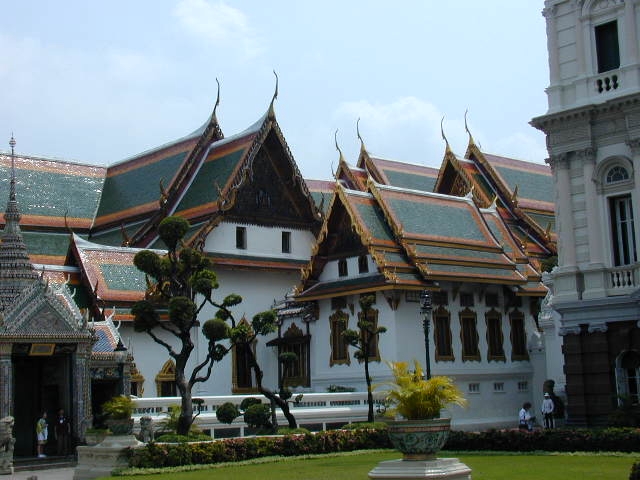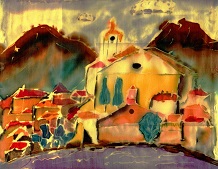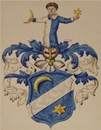zurück
Bangkok :

Royal Palace Königspalast
Bangkok
The Grand
Palace in Bangkok, also
known as the Royal Palace, is one
of the most iconic and culturally significant landmarks in Thailand. It is a
must-visit destination for anyone exploring Bangkok, offering a glimpse into
Thailand's rich history, royal heritage, and intricate architectural beauty.
Here’s everything you need to know about the
Royal Palace in Bangkok:
1.
History and Significance
- The
Grand Palace was built in
1782 during the reign of
King Rama I, the founder of
the Chakri Dynasty (the
current ruling family of Thailand). It has served as the official residence
of the Thai Kings for centuries until the
King Rama IX era, though it
is no longer used as a royal residence today.
- The
Grand Palace is not just a
single building, but rather a complex of buildings, halls, pavilions,
gardens, and courtyards, each with its own historical significance and
architectural style.
- The
King's official ceremonies,
including coronations, royal weddings, and important state events, still
take place in the palace.
2.
Architecture and Layout
-
Traditional Thai Architecture:
The Grand Palace complex features stunning examples of traditional
Thai architecture, with
beautiful roofs, gold-leaf details, intricate carvings, and colorful murals.
It showcases a blend of Thai
and Western influences,
especially during the reign of King
Rama V, who modernized
certain parts of the palace.
-
Phra Thinang (Palace Halls):
The main buildings within the Grand Palace include the
Phra Maha Montien,
Phra Maha Chanok, and
Phra Thinang Amarin Winitchai,
each used for different royal functions.
-
Emerald Buddha Temple (Wat Phra
Kaew): The most sacred and revered temple in Thailand, located
within the Grand Palace complex, houses the famous
Emerald Buddha (a jade
statue of the Buddha). It is considered the spiritual heart of Thailand.
3.
Key Attractions Inside the Grand
Palace
-
Wat Phra Kaew (Temple of the
Emerald Buddha):
- This temple is the most important
religious site in Thailand, and it is often referred to as the
Temple of the Emerald Buddha.
The Emerald Buddha is
a revered national symbol of Thailand, and it is housed in a beautifully
decorated hall.
- The temple features stunning
murals depicting scenes from Buddhist history and traditional Thai art.
The architecture is highly ornate, with golden spires, intricate
carvings, and beautiful mosaics.
-
Outer Court and Inner Court:
- The
Outer Court housed
the administrative buildings, while the
Inner Court was
reserved for the royal family. In the Inner Court, you'll find the
Dusit Maha Prasat Hall,
the Amarin Winitchai Hall,
and the Phimanchai Hall,
each of which is used for ceremonial purposes.
-
The Emerald Buddha: The
Emerald Buddha is
Thailand’s most important religious icon. It is a small, jade-like statue,
and only the king or the royal family is allowed to handle it. The statue is
dressed in different robes according to the seasons, and there is a special
ceremony to change the robes each year.
-
The Chakri Maha Prasat Hall:
This hall is one of the most beautiful buildings in the Grand Palace
complex. It has a unique blend of Thai and European architectural styles,
particularly noticeable in the Western-style roofs and the Thai-inspired
details in the interior.
4.
What to See Around the Complex
-
Outer Court: The
Outer Court was
historically where the government offices and royal guards were located.
Today, it is home to beautiful gardens and several important halls used for
state functions.
-
The Grand Palace Gardens:
The gardens surrounding the Grand Palace are well-maintained and provide a
peaceful retreat from the busy city. The landscape includes manicured lawns,
lotus ponds, and decorative sculptures.
-
The Royal Reception Halls:
These halls, including the Phra
Thinang Chakri Mahaprasat, are used for royal receptions and
meetings, adding to the grandeur of the palace complex.
5.
Dress Code and Visitor Etiquette
-
Strict Dress Code:
Visitors are required to wear modest attire when visiting the Grand Palace
and Wat Phra Kaew. This includes covering the shoulders, arms, and knees.
No shorts,
no sleeveless tops, and
no flip-flops are
allowed. If you do not meet the dress code, you can rent appropriate
clothing near the entrance.
-
Respectful Behavior:
Visitors are expected to be respectful of the sacred nature of the temple
and the royal significance of the palace. It is considered disrespectful to
point your feet at statues or religious images, and it is important to show
reverence when near the Emerald
Buddha.
6.
Best Time to Visit
-
Opening Hours: The Grand
Palace is typically open daily from
8:30 AM to 3:30 PM.
However, it is advisable to check the opening hours before your visit, as
they may vary due to special events or ceremonies.
-
Crowd Levels: The Grand
Palace can get crowded, especially in the late morning and early afternoon.
Arriving early in the morning is recommended to avoid the largest crowds.
-
Avoid Holidays: The Grand
Palace is particularly busy during Thai public holidays, especially those
related to the monarchy or religious events, so it’s best to plan your visit
around these times if you prefer a quieter experience.
7.
Admission Fees
-
Entrance Fee: As of
recent updates, the entrance fee for foreigners is around
500 Thai Baht (approx.
USD 15). This fee includes entry to the Grand Palace and the
Temple of the Emerald Buddha.
-
Free Admission for Thai Citizens:
Thai nationals can enter the Grand Palace for free.
8.
How to Get There
-
By Boat: You can take a
chao praya river boat to
the Tha Chang Pier and
walk to the Grand Palace from there. This is a scenic and popular route, as
it allows you to enjoy the views of the river and surrounding areas.
-
By Taxi or Tuk-Tuk: Taxis
and tuk-tuks are widely available throughout Bangkok, and the Grand Palace
is located near many major roads, making it easy to reach by car.
-
By Bus: Several public
buses also stop near the Grand Palace, though they might not be as
convenient for tourists unfamiliar with the routes.
 26.07.25 Copyright Dirk
Rauschenbach Koelnerstrasse 293 51702 Bergneustadt
Datenschutzerklaerung 02261 9788972 Mail ccooly(
at) web.de
26.07.25 Copyright Dirk
Rauschenbach Koelnerstrasse 293 51702 Bergneustadt
Datenschutzerklaerung 02261 9788972 Mail ccooly(
at) web.de
 Safaris
Bergsteigen
Wandern
Inselwandern Weltweit
Safaris
Bergsteigen
Wandern
Inselwandern Weltweit
 Europa
Inselwandern
Europa
Inselwandern
 Städtewandern
Städtewandern
 Paintings
Paintings Dirk Rauschenbach
Dirk Rauschenbach
 Safaris
Bergsteigen
Wandern
Inselwandern Weltweit
Safaris
Bergsteigen
Wandern
Inselwandern Weltweit
 Europa
Inselwandern
Europa
Inselwandern
 Städtewandern
Städtewandern
 Paintings
Paintings Dirk Rauschenbach
Dirk Rauschenbach
![]() 26.07.25 Copyright Dirk
Rauschenbach Koelnerstrasse 293 51702 Bergneustadt
Datenschutzerklaerung 02261 9788972 Mail ccooly(
at) web.de
26.07.25 Copyright Dirk
Rauschenbach Koelnerstrasse 293 51702 Bergneustadt
Datenschutzerklaerung 02261 9788972 Mail ccooly(
at) web.de